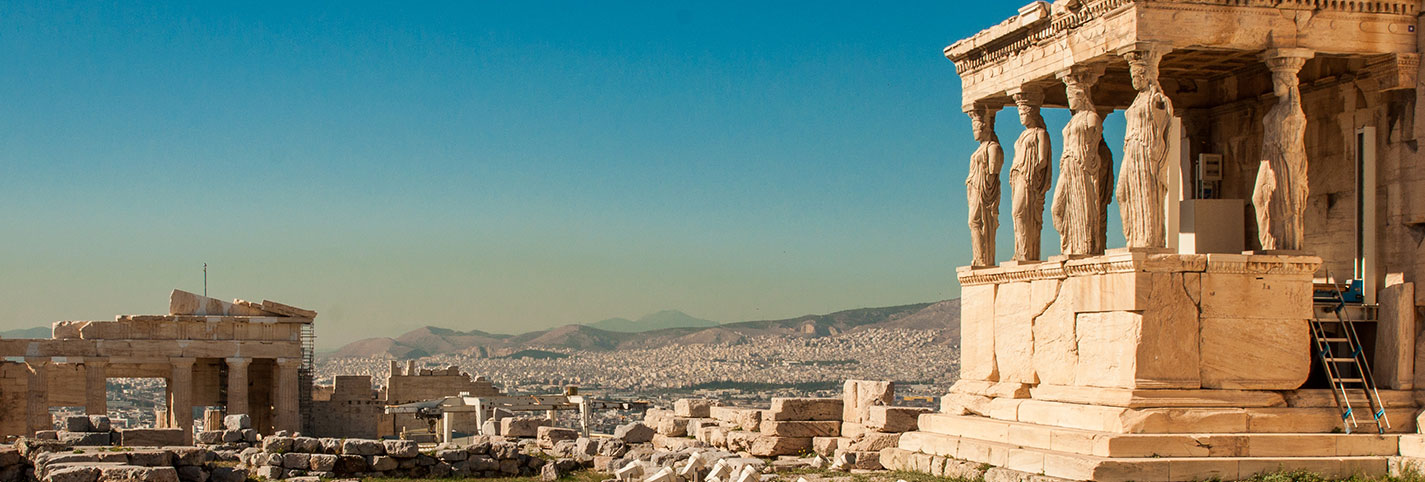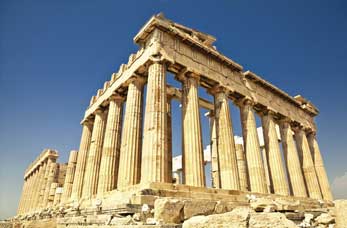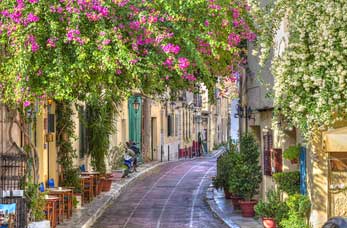
0800 408 0757
Call Us
Sales Team
0800 408 0757Customer Services Team
01792 705301**Calls cost up to 4p per minute plus your phone company’s access charge

Athens is one of the most beautiful and fascinating cities in Europe. The picturesque port of Piraeus has been welcoming ships for over 1500 years and Athens continues to attract cruise ships from around the world. The reason that Athens is so popular is because it combines world class culture with a warm family atmosphere. It doesn’t matter if you’re wandering down the streets of Plaka at 10pm, you’re still guaranteed to see different generations of Athenian families sitting out together and enjoying a late-night coffee. If you are looking for a cruise destination with plenty of sights and activities to keep you occupied, then look no further than Athens. Bring a pair of comfortable shoes; Athens will certainly keep you busy.
Here is a pick of the best things to see, eat, and experience while you stay in this ancient city.
Athens is a truly ancient city and has been continually occupied since the Neolithic period. One of the earliest signs of human habitation come from the Athenian Acropolis, where there is archaeological evidence that the Mycenaeans occupied the citadel during the Bronze Age (nearly 3000 years ago). However, as legend goes, the city of Athens was founded by the Greek goddess Athena long before. According to the myth, there was a contest between Athena (goddess of wisdom) and Poseidon (the god of the sea) over who would be patron of the city. In order to win over the city’s inhabitants, Poseidon threw his trident into the rocks of the Acropolis. Out poured a fresh water spring and Poseidon was met with popular acclaim. Athena, however, had another idea. She gifted Athens with an olive tree; the agricultural product which would form the basis of olive oil, various beauty products, and the Greek diet. The Athenians were swayed and unanimously voted Athena to be their patroness. The city was then named after her accordingly.
However, the ‘Golden Age’ of Athenian civilisation was certainly during the Classical age (from 480-323 BCE). Towards the end of the Persian Wars, the Achaemenid King, Xerxes, marched towards Athens and sacked the city. The Acropolis was burnt to the ground and many Athenians were forced to flee for their lives. Although the future of Athens looked grim, the destruction of the city became its saving grace.
Following the formation of the Delian League, a treaty of peace between all the city-states of Greece, Athens procured a vast wealth of money from her allies. Under the watchful eye of the Athenian General Pericles, Athens went under a serious urban renovation. The Delian League money was used to refurbish the city (much to the dismay of the other city-states) and Athens built its famous Parthenon. Although it has long since been destroyed, the Parthenon contained within it a mammoth sculpture of Athena. The sculpture was made of ivory and gold and was nearly 13m in height (41.9ft). Combined with the construction of the Piraeus Port, Athens became one of the wealthiest and most influential cities in the Mediterranean.
During the Classical Period, Athens became the centre of educational, political, and artistic advancement. In 479 BCE, Athens put on the first ever theatre production on the slopes of the Acropolis (Aeschylus’ The Persians). However, in addition to this, one of the most notable achievements of the Athenians was the implementation of political democracy; a practice which allowed all Athenian citizens the right to vote on matters which concerned the demos (the people). However, it should be noted, that Athenian Democracy didn’t give the vote to slaves, women, or non-citizens. Nevertheless, the implementation of democracy by Athens has become one of the most important turning points in European history.
During the Classical Period, Athens became a centre for philosophical thought and was home to some of the most notable figures in history (including Aristotle, Plato, and Socrates). Although Athens continued to flourish for several generations, the outbreak of the Peloponnesian War (437-404 BCE) had a catastrophic impact on the city. After a series of blockades and droughts, Athens succumbed to the plague and the population dropped significantly. By the end of the war, moreover, Athens had suffered terribly and was eventually defeated by Sparta and her allies. Although the city would always remain inhabited, nothing was ever quite the same.
By the time of the Romans, Athens no longer held its position of political influence and economic prosperity. However, it was a remarkable achievement for the Romans to incorporate Athens into its Empire. The city was incredibly well respected, especially by Hadrian, and Athens was once again renovated. The Romans built an Agora in the city-centre and religious pilgrims flocked to the city throughout the ancient period.
If you are looking for things to do in Athens, then you really are spoilt for choice. An obvious starting point would be the Acropolis; a popular destination for tourists from many of the cruise ships which dock in Piraeus. However, Athens has much more to offer beyond its ancient heritage. Sites such as The Ottoman Bathhouse, the Museum of Archaeology, and Athenian House of Parliament are all worth a visit. In addition to this, Athens is home to some of the most incredible festivals in the world. Depending on the time of year, you’ll be able to see the Jazz Festival or one of the many city theatre festivals.
The Parthenon is located upon the Athenian Acropolis. The Acropolis has many wonderful sights that are worth exploring, including the Theatre of Dionysus and Herod’s Odeum. However, there can be no doubt that the Parthenon is the most popular and spectacular site within Athens.
The word Parthenon comes from the Greek Parthenos, which is usually translated as meaning ‘female divinity’ or ‘virgin’. Given that the temple was specifically dedicated to Athena and that it was used for many religious festivals (such as the Panathenaia), the name stuck. It was built between 447-432 BCE and was one of the most expensive and jaw-dropping constructions of its time.
If you are visiting the Parthenon today, then the site looks much different from when it was originally constructed. The site has been hit by multiple earthquakes, was used as target practice by the Ottomans, and was even an armery during WW2. During Nazi occupation, the Parthenon was hit by a bomb and endured significant damage. To this day, renovations are still taking place on the site. With that in mind, then, don’t be surprised to see lots of scaffolding around the Parthenon.

If you are visiting during the summer, then it’s a good idea to visit the Parthenon early in the morning. The Acropolis is always incredibly busy and will become very hot in the afternoons. In terms of accessibility, furthermore, the Acropolis can be very steep in areas so is potentially hazardous to young children and older people.
At one point, the Agora was the civic centre for the ancient city of Athens. This is where Athenians came to do their shopping, visit law courts, and meet other people. Today, the Agora is a lovely green space in the middle of the city. It’s a great option for tourists who want to enjoy the city but fancy a quiet place to sit in the shade.
The Agora has a mixture of Greek and Roman statues, and a wonderful museum (The Agora Museum). The Museum contains everything you would expect: lots of statues, plenty of vases, and some beautiful reliefs from the surrounding area. One of the most sculptures you’ll see here is the bust of Herodotus; the ‘father’ of modern history.
The Acropolis Museum is undoubtedly one of the best museums in Europe. For a minimal fee, tourists get to wander around a beautifully air-conditioned exhibition and marvel at the Parthenon reliefs. The museum is arranged so that the metopes and reliefs are in-situ as they would appear on the actual Acropolis. This is not a sight to be missed.
Beyond the Parthenon reconstruction, the Acropolis also gives a fascinating history of how Athens developed into an urban city. The Museum itself is actually built upon an active archaeological site. Tourists, if they’re feeling brave, can look down through the glass floor and see the ancient rubble.
This Museum is genuinely wonderful and offers a pleasant escape from the fiery Greek heat. Like the Acropolis itself, get there early to avoid disappointment.
Sometimes, it can feel like there’s nowhere to go in Athens that isn’t jammed pack with tourists and locals. However, if you are interested in going off the main route, you can find a real gem. The Ottoman Bath House is a wonderful experience and gives tourists a great idea of what it was like to live in 19th Century Athens. The site has been faithfully reconstructed and includes many of the original features. Visitors can expect to see various beautifully decorated and incredibly ornate bathrooms, changing rooms, and spaces where Greek-Ottomans socialised.
The Greeks are famous for their food and drink, and Athens doesn’t fail to disappoint. If you are looking for a quick bite to eat, then there are some local delicacies which you have to try. Souvlaki (a type of Greek kebab) is something you’ll see sold throughout Athens and is great for lunch. Many different eateries will boast that they sell the best souvlaki in Athens, but the choice is really up to you. In addition to souvlaki, tourists are often fond of traditional Greek cheese pastries. The cheese pastries are usually made of feta but often come with other accompaniments, including spinach and ham. They are available on virtually every street corner and are very cheap.

Athens has a fantastic coffee culture and there is a plethora of options for the thirsty and coffee connoisseurs alike. Without a doubt, the most popular coffee drink is the frappe - a cold cappuccino often served at breakfast time with a sweet pastry. Be wary, though; Greek coffee can be incredibly strong and often very sweet. If you have a particular preference, let your barista know.
Ever since the 2004 Summer Olympics, Athens has undergone some serious renovation. One of the best outcomes of the Olympics, for the city, was the refurbishment of Athens’ underground tube network. This means that getting around Athens is remarkably easy and is a pleasant experience in itself.
If you are interested in venturing beyond Athens during your cruise, you have a number of options. Although it’s very popular for tourists to visit Olympus and Delphi, they are several hours away from Athens by bus. If you have the time, by all means, then you should visit these wonderful towns. However, there are alternatives if you’re more strapped for time.
Argos is a lovely and quaint city located roughly 86 miles away from Athens. It’s easily accessibly by bus and offers a quiet retreat from the hustle and bustle of city-living. There are plenty of nice restaurants and Argos’ city square is a great place to enjoy a drink in the evening. You’ll see plenty of locals enjoying the summer’s evening here and accommodation is surprisingly affordable.
In addition to Argos, it’s definitely worth making the short journey to Mycenae while you are visiting Athens. The Bronze Age site has some truly remarkable architecture and features ‘cyclopean’ masonry; an architectural style which is used to describe the massive blocks which built the Mycenaean Citadel. Furthermore, Mycenae was also the hometown of legendary Greek King Agamemnon (the husband of Clytemnestra and leader of the Greek troops during the Trojan Wars). Mycenae is situated in the beautiful Greek countryside and is surrounded by endless rolling hills. The site is definitely worth a visit if you desire an escape from busy Athens.
Athens is a great location for cruisers because there’s simply so much to do. The city is one of the oldest and most fascinating in Europe, attracting thousands of international tourists every year. Some of the must-see sites include the Acropolis (and its museum), the Agora, and the hidden Ottoman Bathhouse. In terms of experiencing Athens, the Plaka area is a wonderful way to visit various restaurants and buy ice-cold frappes. This is a popular area for tourists and locals alike.
Athens is a wonderful visit because you aren’t limited to the city either. It’s ideally situated for further travel, with cities like Argos and Mycenae very closeby. You can venture further if you have the time and Athens has excellent transport links.
Athens really does have something for everyone. The city has a wonderful atmosphere and will never fail to impress.
Article read 2851 times.